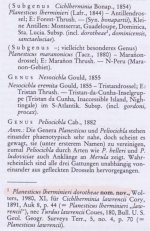You´re welcome James! Only glad to help, and while we´re at it; I might post this one as well, regarding ...
PSEUDOCOLOPTERYX
[...]
Diagnosis not yet seen (Lillo 1905, La Revista de letras y ciencias sociales de Tucumán, 3 (13), 48).
Not seen in full, but
Google Snippet view here, from Miguel Lillo's Paper
Fauna tucumana : Aves, catálogo sistemático*, Revista de Letras y Ciencias Sociales (Tucumán) 3, 1905, pp. (1-41) 4-41 (not "48"?):
Pseudocolopteryx (nuevo género). Este género se diferencia de todos los demás tiranidos, por la estraña estructura de las plumas remeras en los machos; en efecto la cuarta y quinta son estremadamente estrechas y do solodos tercios del largo normal. Tales remeras se ...
*"A new ed. of a study published in the
Anales del Museo Nacional de Buenos Aires, v. 8, p. 169-221.", according to Hathi Trust Digital Library,
here. ... which leads us back to 1902,
here (but without the
Pseudocolopteryx).
Regarding the former Journal
Revista de Letras y Ciencias Sociales (Tucumán), vol. 3, according to
here: "Public domain only when viewed in the US" ...
If of any help?
Björn
PS. Beware of typos in the second quote! I just typed away, understanding nothing.
-





